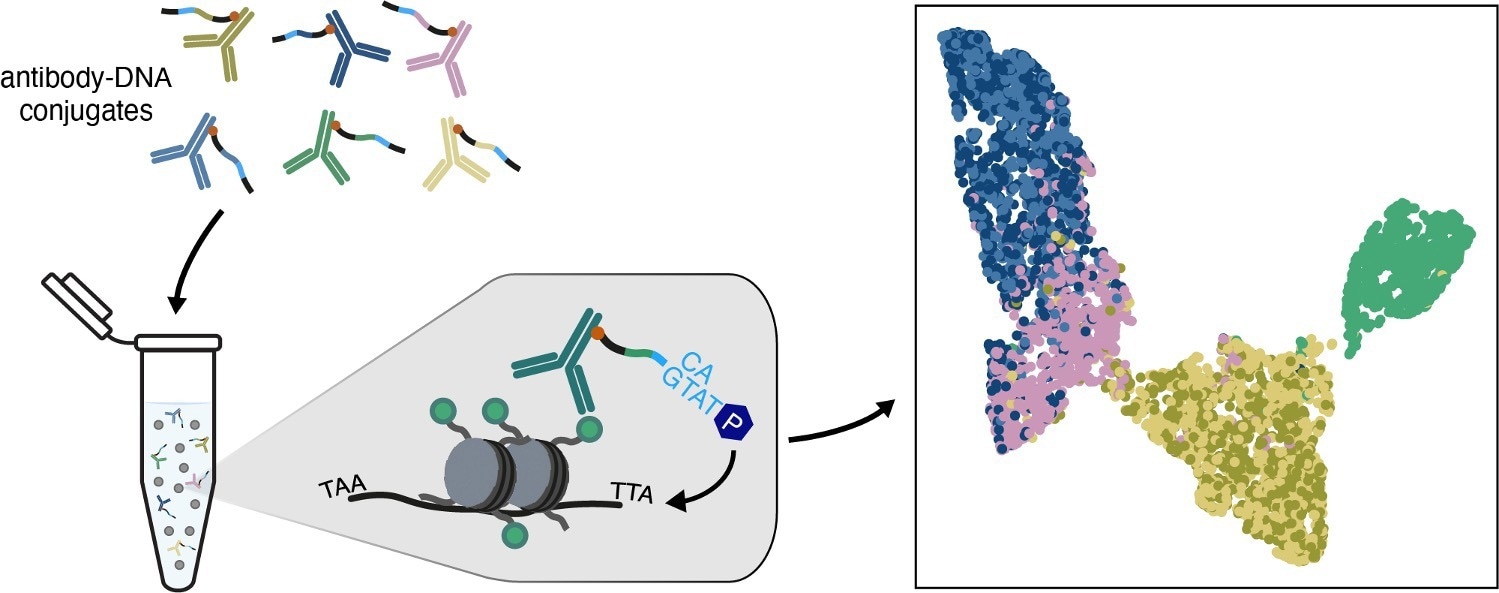A novel technique named MAbID, developed by researchers led by Jop Kind, has been introduced to concurrently investigate various mechanisms of gene regulation, crucial for both development and disease processes.
 MAbID in a nutshell. Left: antibodies, each binding a specific histone modification or protein, are merged with individual cells. After these antibodies have bound, a small barcode is attached to the adjacent DNA using the MAbID procedure. Right: these barcodes are then read, allowing the location of each histone modification on the DNA to be determined for each individual cell. This information allows the creation of cellular atlases that clearly identify the similarities and differences between cells. Image Credit: Robin van der Weide.
MAbID in a nutshell. Left: antibodies, each binding a specific histone modification or protein, are merged with individual cells. After these antibodies have bound, a small barcode is attached to the adjacent DNA using the MAbID procedure. Right: these barcodes are then read, allowing the location of each histone modification on the DNA to be determined for each individual cell. This information allows the creation of cellular atlases that clearly identify the similarities and differences between cells. Image Credit: Robin van der Weide.
MAbID provides fresh perspectives on the collaborative or conflicting interactions of these mechanisms.
The findings were recently published in the journal Nature Methods on December 4th.
Genetic information is primarily encoded in DNA, the essential carrier of this information. Within each cell, around 2 m of DNA is present.
Efficient utilization of the limited space in the small cell nucleus requires tight packing of this genetic material. This compact arrangement involves wrapping the DNA around a specialized protein known as histone, forming structures called chromatin.
Reading DNA
Chromatin serves a dual purpose by not only facilitating the accommodation of all DNA within the cell but also influencing which segments of the genetic material are accessible for reading by the cell. Specifically, DNA tightly wound around histones poses a greater challenge for the cell to read compared to more loosely packed DNA.
Ultimately, the folding pattern of chromatin dictates the expression or suppression of specific regions within the genetic material. This unique pattern of gene expression varies across different cell types; for instance, the set of active genes in a skin cell differs from that in a liver cell.
Changes in Chromatin
Gene activity is not constant; it can vary between different moments due to changes in chromatin structure.
These alterations encompass modifications to histones, referred to as histone modifications, as well as the binding of specific proteins to the chromatin. Both of these processes exert an impact on the readability of DNA, consequently influencing gene expression.
New Technique
In the past few years, several technologies have emerged to explore the intricacies of gene regulation mechanisms. However, a gap persisted in having a technique that enables researchers to concurrently examine multiple mechanisms within a single cell.
To address this, the team led by Jop Kind developed a novel approach known as MAbID. This innovative technique empowers researchers to simultaneously investigate various types of histone modifications and the proteins binding to chromatin.
Working Together
With our new technique, we can see how the different mechanisms of gene expression are connected, for example how they work together or against each other. And the great thing is that we no longer need separate experiments for this, we can study everything at once in each individual cell. That makes the research much more efficient.”
Silke Lochs, Researcher, Hubrecht University
Applications
The technology could be extensively applied. Robin van der Weide.
MAbID can help us answer fundamental scientific questions, for example about how gene regulation works during the development of humans or animals. But we can also use it for research into the development of diseases that can be caused by abnormalities in gene regulation, such as cancer.”
Robin van der Weide, Researcher, Hubrecht University
This versatile technology holds the potential to offer crucial insights into both health and disease in the future.
Source:
Journal reference:
Lochs, S. J. A., et al. (2023) Combinatorial single-cell profiling of major chromatin types with MabID. Nature Methods. https://doi.org/10.1038/s41592-023-02090-9.